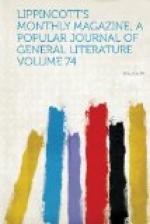The Childs were the greatest mercantile family of their time. Sir Joshua founded the banking-house of the name which still flourishes (the oldest in London), and of which the young earl of Jersey is, through his great-grandmother, also a Child heiress, the principal partner. Sir Joshua’s son was raised to a peerage as Earl Tylney, and about 1715 employed a celebrated architect of the day, Colin Campbell, to build a magnificent mansion. Wanstead was deemed on its completion in many respects the most magnificent house in England. It was of Portland stone, two hundred feet in length and seventy deep. The great hall was fifty-three by forty-five feet, the ball-room seventy-five by twenty-seven. This abode was furnished in a style of the most lavish splendor, and Mr. Wellesley-Pole’s income was more than adequate to maintain it in befitting style. But no income is adequate to meet the expenses of a gambler and spendthrift, and such was Mr. Wellesley-Pole.
Some of his wife’s property was happily settled on her and her heirs, and could not be got hold of by her rascally husband; but Wanstead, after being leased for some time to the duc de Bourbon—who here received intelligence of the death of his unfortunate son, the duc d’Enghien—came to the hammer. The sale of the effects in 1822 exceeded anything of the kind which had been known in England up to that date. The catalogue consisted of four hundred quarto pages, published in three parts, at five shillings each, and it is said that not less than twenty thousand copies were sold. It is not a little remarkable that the contents of Fonthill Abbey (the celebrated seat of the author of Vathek), which teemed with even greater riches, were sold almost at the same time. Nor were the contents of the mansion only disposed of. The fabric itself, which had cost three hundred and sixty thousand pounds, was sold for eight thousand pounds, it being a condition of the sale that it should be razed and the materials removed within a definite number of months.




